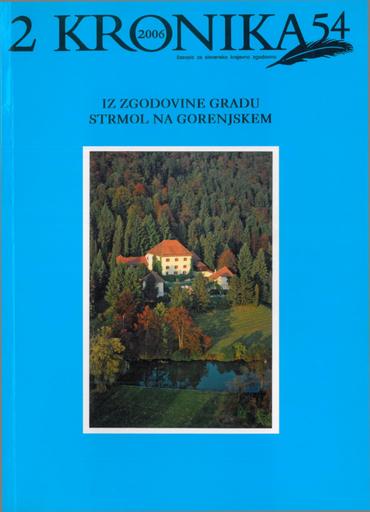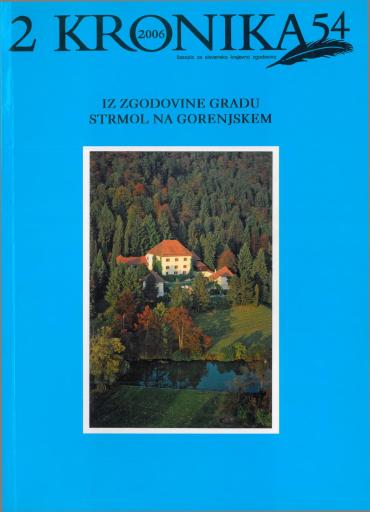/
Periodicals
/
Kronika: časopis za slovensko krajevno zgodovino
The Strmol Castle Interiors Before 1945 And After

Author(s):Vesna Bučić
Co-author(s):Miha Preinfalk (odg. ur.)
Year:2006
Publisher(s):Zveza zgodovinskih društev Slovenije, Ljubljana
Source(s):Kronika, 2006, št. 2
Language(s):slovenščina
Type(s) of material:text
Keywords:Grad Strmol, Rado in Ksenija Hribar, protokol, denacionalizacija, grajski interierji, Strmol castle, Rado and Ksenija Hribar, protocol, denationalisation, castle interiors
Rights:

This work by Vesna Bučić is licensed under Creative Commons Attribution-NonCommercial-NoDerivs 4.0 International
Files (1)

Name:Kronika-2006_2_pop.pdf
Size:82.56MB
Format:application/pdf
Permanent link:https://hdl.handle.net/11686/file23242
Description
In 1936, the wealthy Ljubljana industrialist Rado Hribar bought the completely emptied castle of Strmol and equipped it with period furniture and with small precious inventory, which he was purchasing in antique shops and at auctions, and according to recent data, from the Velesovo church and monastery. The luxurious castle interiors survived untouched after the liquidation of the wedded pair Rado and Ksenija Hribar in 1944, the maelstroms of war; thus, Strmol is one among few Slovene castles that preserved after 1945 the equipment of the last lord of the castle, and became state facility of the Yugoslav and later of the Slovene governments.
Metadata (12)
- identifierhttps://hdl.handle.net/11686/4625
- title
- Strmolski interierji, pred letom 1945 in po njem
- The Strmol Castle Interiors Before 1945 And After
- creator
- Vesna Bučić
- contributor
- Miha Preinfalk (odg. ur.)
- subject
- Grad Strmol
- Rado in Ksenija Hribar
- protokol
- denacionalizacija
- grajski interierji
- Strmol castle
- Rado and Ksenija Hribar
- protocol
- denationalisation
- castle interiors
- description
- In 1936, the wealthy Ljubljana industrialist Rado Hribar bought the completely emptied castle of Strmol and equipped it with period furniture and with small precious inventory, which he was purchasing in antique shops and at auctions, and according to recent data, from the Velesovo church and monastery. The luxurious castle interiors survived untouched after the liquidation of the wedded pair Rado and Ksenija Hribar in 1944, the maelstroms of war; thus, Strmol is one among few Slovene castles that preserved after 1945 the equipment of the last lord of the castle, and became state facility of the Yugoslav and later of the Slovene governments.
- Leta 1936 je premožni ljubljanski industrialec Rado Hribar kupil skoraj izpraznjen grad Strmol in ga opremil s stilnim pohištvom in drobnim žlahtnim inventarjem, ki ga je kupoval po antikvariatih in na dražbah, po najnovejših podatkih tudi iz velesovske cerkve in samostana. Bogato opremljeni grajski interierji so po likvidaciji zakoncev Rada in Ksenije Hribar leta 1944 nedotaknjeni preživeli vojne vihre in Strmol je eden izmed redkih slovenskih gradov, ki je po letu 1945 ohranil opremo zadnjega graščaka in postal protokolarni objekt jugoslovanske in pozneje slovenske vlade.
- publisher
- Zveza zgodovinskih društev Slovenije
- date
- 2006
- type
- besedilo
- language
- Slovenščina
- isPartOf
- rights
- license: ccByNcNd
Citirano v (2)
| Tipologija | Avtor(ji) | Naslov | Kraj | Založba | Leto |
|---|---|---|---|---|---|
| 1.01 Izvirni znanstveni članek | Lozar Štamcar, Maja | Grad kot plemiško bivališče | Zgodovinsko društvo za Slovenijo | 2012 | |
| 1.01 Izvirni znanstveni članek | Bučić, Vesna | Josip Gorup pl. Slavinjski - med gospodarstvom, umetnostjo in družino | 2007 |
Seznam literature v delu (5)
| Stran | Avtor | Naslov | Vir | Kraj | Založba | Leto |
|---|---|---|---|---|---|---|
| 356 | Bučić, Vesna | Ure skozi stoletja | Ljubljana | Narodni muzej | 1990 | |
| 350 | Bučić, Vesna | Brdski interjerji v preteklosti in sedanjosti | Kronika | 2004 | ||
| 359 | Granda, Stane | Josip Gorup - najbogatejši Slovenec, pa ne le zase | Slavenski zbornik | Vrhnika | Galerija 2 | 2005 |
| 349 | Komelj, Milček | Kronika Marjana Pogačnika o zaljubljencih v umetnost | Ljubljana | 2005 | ||
| 348 | Stopar, Ivan | Grajske stavbe v osrednji Sloveniji : Gorenjska: Knjiga 1: Ob zgornjem toku Save | Ljubljana | Viharnik | 1996 |
